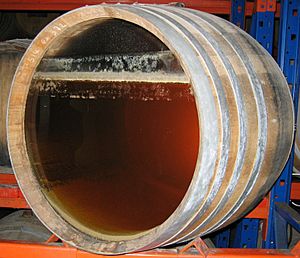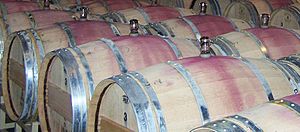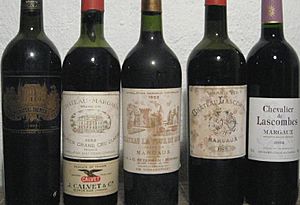Ullage (wine) facts for kids
Ullage (pronounced "YOU-lidge") is a special word used in winemaking. It mostly means the empty space of air between the wine and the top of its container, like a bottle or a barrel.
This space forms because some of the wine slowly turns into vapor and escapes. This process is called evaporation. The air in this space is mostly alcohol and water vapor, plus some carbon dioxide from the wine's creation.
If the container isn't completely sealed, like an oak wine barrel or a bottle with a cork, oxygen can also get into this space. A little oxygen helps wine age well, but too much can spoil it. That's why winemakers often "top up" barrels with more wine to keep the air space small.
For wine in bottles, the ullage (or "fill level") can show how well the wine was stored. People who sell old wines often check the ullage to guess the wine's quality and value.
Ullage in Wine Barrels
In a winery, wine slowly evaporates from barrels. This loss is sometimes called the "angel's share". As the alcohol and water vapors escape, oxygen from the air can enter the barrel.
A small amount of oxygen helps the wine mature. But too much oxygen can cause problems. It can mix with tiny germs called Acetobacter in the wine, which can turn the wine into vinegar.
To stop this, winemakers regularly "top up" their barrels. This means they add more wine to fill the barrel to the very top. This keeps the air space small and protects the wine.
How often barrels are topped up depends on the winery and the type of wine. It can be anywhere from once a week to every month and a half. The way a barrel sits can also affect how fast wine evaporates. If the barrel's opening (called a bung hole) is on top, more air gets in. If it's on its side, the bung stays wet with wine, and less air gets in.
Ullage in Wine Bottles
The ullage level in a wine bottle is also called the "fill level." This is the space between the wine and the bottom of the cork. When wine is first bottled, this space is usually very small, about 0.2 to 0.4 inches (5 to 10 mm).
Over time, as wine ages in the bottle, some of it evaporates through the cork. This makes the ullage space bigger. If a bottle is stored on its side, some wine can also soak into the cork itself, which also increases the ullage.
Generally, a larger ullage space means the wine might have been exposed to too much oxygen. This is why wine sellers and auction houses check ullage levels carefully. It helps them decide how much an old bottle of wine is worth.
The ullage level can also show how well the wine was stored. Wines kept in cool, steady temperatures (around 50–59 °F or 10–15 °C) and with good humidity will evaporate slower. This means they will have smaller ullage levels.
Most wines can be damaged by too much oxygen. However, some wines, like Madeira wine, are made to be exposed to oxygen and are not harmed by it.
Understanding Ullage Levels
Wine experts use special terms to describe the ullage levels in wine bottles. These terms can be different for wines from different regions, like Bordeaux and Burgundy, because their bottles have different shapes.
In the late 1980s, a wine expert named Michael Broadbent created a guide for checking ullage levels in older wines. Even though his guide focused on Bordeaux wines, it is now used widely for many types of wine. These terms help describe the amount of wine left in a bottle and are often used when old wines are sold at auctions.
| Ullage Level (inches/cm) | What it Looks Like | What it Means |
|---|---|---|
| 0.12 in (0.3 cm) | Very high, almost touching the cork | Normal for new wines |
| 0.2 in (0.5 cm) | High in the bottle's neck | Good condition for any age of wine |
| 0.6 in (1.5 cm) | At the top of the bottle's "shoulders" (the widest part before the neck) | Normal for older wines. Good for wines over 15 years old. |
| 1 in (2.5 cm) | In the upper part of the shoulders | Usually okay for very old wines, especially those over 20 years old. |
| 1.18–1.38 in (3–3.5 cm) | In the middle to lower part of the shoulders | Might have been exposed to too much oxygen. The price should show this risk. |
| 2.36–2.75 in (6–7 cm) | Low on the shoulders or below them | Very risky. The wine might not be good to drink. |




